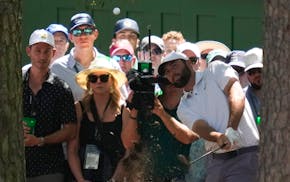The world's best golfers will gather at historic Merion this week for the U.S. Open. I can't wait to see the most influential figure in the game become the story again.
This figure has repeatedly confounded Tiger Woods, kept Dustin Johnson from his first major title, ruined the legacy of a great Argentine, and tormented champions and would-be champions alike.
The most influential figure in the game today is not Woods, who hasn't won a major since Barack Obama was elected president.
It's the Rules of Golf, a booklet that is impossible to memorize and sometimes just as hard to understand.
When Woods was accused of dropping his ball in the wrong place during the Masters, many of the best players in the game admitted they didn't know all of the rules of their game.
Former Masters champion Zach Johnson said it was impossible to memorize or even comprehend the rules, and he wasn't even anticipating the latest example of golf's hyperpunitive nature: Two-time U.S. Open champion Lee Janzen being disqualified from an Open qualifier last week because he didn't read the rule that banned metal spikes.
Every sport chafes at the tension created between the letter of the law and the way officials interpret those rules. No game creates more problems for itself than golf.
It should be the simplest game with the simplest rules. Instead, golf often finds ways to make itself look as silly as a grown man wearing knickers and saddle shoes.
Dustin Johnson made a mistake. So did Janzen. Both forgot that the rules of the game — and interpretations of those rules by individual golf courses — are treated as more important than the competition itself.
Here's what these silly "Rules" have wrought:
Roberto De Vicenzo should have qualified for a playoff at the 1968 Masters, but playing partner Tommy Aaron wrote down that De Vicenzo made a par instead of a birdie on the 17th hole, so De Vicenzo "lost" the tournament.
Dustin Johnson should have participated in a playoff at the 2010 PGA Championship, but he failed to recognize that a smattering of sand that had been walked through by thousands of spectators qualified as a bunker under the rules of the tournament at Whistling Straits. He grounded his club on a few grains of sand and was punished as if he had foot-wedged his ball 15 yards.
At the U.S. Open in 1946, Byron Nelson's caddie accidentally kicked his ball while it was on the green. Nelson was assessed a penalty and instead of winning in regulation, he lost in a playoff.
At the British Open in 2001, Ian Woosnam birdied the first hole of the final round to take the lead, then was penalized because his caddie stuck an extra driver in his bag.
At the 2003 British Open, Mark Roe shot a 67 in the third round, but was disqualified because he and playing partner Jesper Parnevik neglected to exchange scorecards before their round.
At the 1957 U.S. Women's Open, Jackie Pung was disqualified for signing a card that bore the correct overall score but contained a mistake in the hole-by-hole accounting.
At the 1950 U.S. Open, Lloyd Mangrum blew on his ball to remove a gnat during the playoff and was given a two-stroke penalty.
Imagine if, instead of an arcane and lengthy rule book, golf was governed by one simple rule: Each player will try to put the ball in the hole in as few strokes as possible without taking an unfair advantage.
If a player cheats, he or she should be penalized harshly. If a player inadvertently makes an inconsequential mistake, he or she should not be penalized at all.
After losing the Masters, De Vicenzo famously said: "What a stupid I am."
But he wasn't stupid. He was the unsuspecting victim of a criminally unfair ruling and the bureaucratization of an otherwise beautiful sport.
Jim Souhan can be heard weekdays at noon and Sundays from 10 to noon on 1500 ESPN. His Twitter name is @SouhanStrib. jsouhan@startribune.com

Souhan: Why Tiger Woods should keep swinging
Souhan: Scheffler wins Masters again, shows what makes him special
Morikawa falters in final round at Masters

Keeping up with the Joneses who helped design Augusta National's classic back nine

